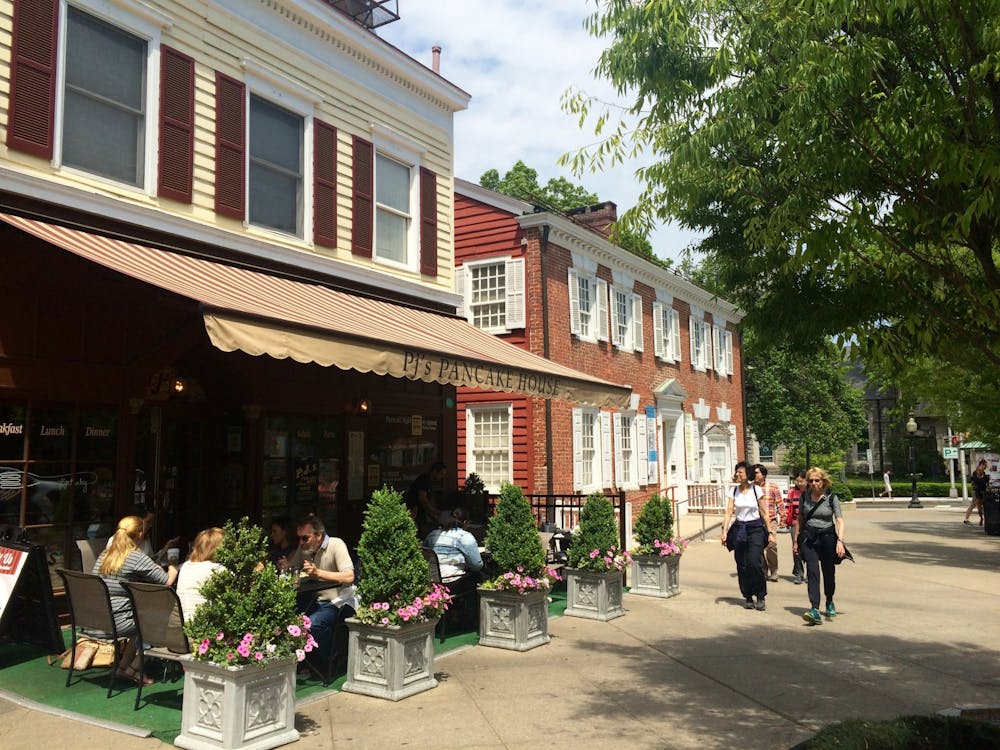Glasses. Those simple little objects that magically clarify the world of the nearsighted and farsighted alike. They're everywhere these days; in fact, mine are lying around my room somewhere unknown to me as I write this. But I'm not too concerned about their missing status — I only wear them late at night when my eyes burn from the twelve hours I have spent with contacts welded to them. There is good reason for this: I think my frames are hideous. Thin and purple and barely noticeable, I keep them hidden, only busting them out in emergencies. Given my unfortunate selection of optical aids, I decided to find people who had made more auspicious choices in their eyewear. What I discovered was quite surprising.
I began my quest by heading over to Au Courant, a trendy eyewear store in Palmer Square. There I met Gary Lavarone, who guided me through the basics of current fashion trends. There are two popular looks right now: thick plastic frames and thin wire frames. For the plastic look, Lavarone recommends frames by either La Font or Booth and Bruce. For wire frames, he suggests "Oliver Peoples." I was impressed by his selection, and he told me the store's selection accounted for a wide range of customers.
"We have the best materials and the most current styles," Lavarone said.
I had noticed that many women (and men) on campus seem to wearing thick, dark plastic frames these days, so I approached Elisheva Coleman '05, and asked her how she chose her glasses.
"I went out and chose a pair exactly like the last frames I had, only in a slightly lighter shade," she said.
When asked if her choice was motivated by the current popularity of such frames (hers are elongated, brown rectangles), she informed me that she didn't really care and had had her old frames for years, before they became the fashion.
Overhearing our conversation, Janine Jaffe '05 said she had not cared at all about the latest styles when purchasing her (fashionable) glasses (dark-colored wire ovals). Instead, she had been concerned with exactly what shape of frame would best suit her face. In fact, she even told me about a new site (www.designer-eyeglasses.com) that allows you to upload a picture of your face and try on different pairs of glasses virtually in order to see which ones are your complements. Now that she has found the perfect style and shape of frame, she plans to "stick with them," regardless of changing styles.
Sitting in my sculpture class, I noticed Professor James Seawright sporting the popular thick-framed black glasses and asked him how he had selected his eyewear. I was disappointed to find that my professor was no trendsetter — he, too, had selected his glasses for functional purposes.

"I needed reading glasses," he explained, "and these ones have small enough rims that I can look down over them."
He also owns a pair of thin, wire-rimmed glasses for distance viewing, but he admitted he hardly ever wears them. After a bit more discussion, Professor Seawright revealed to me his true optical fantasy — he loves "those English doctor spectacles with the tiny, round frames and the super-narrow wire rims." In spite of his admiration for such glasses, purposes of functionality won out as regards his eyewear.
Once again, style lost to functionality.
Learning of Seawright's dream eyewear led me to wonder whether or not other professors care about their look — and to the point of having fantasies about their glasses. Though many encounters on campus had led me to believe otherwise, I was determined to get another "senior" opinion on optical fashion. During a routine Shakespeare lecture, I noticed that Professor Larry Danson had a pair of thin, brown frames. His glasses do not just enable him to see his notes — they also act as props in his interactions with the class. While waiting for late arrivals to finish streaming in, the earpiece of the glasses found their way into his mouth. When he was making a serious point, his frames were clutched tightly in his fist, which was pounding out his meaning. When he was really excited, his arms (and glasses, unfolded) would flail about. Clearly, I had found a man whose eyewear was important to him. I needed to know how he had selected his frames.

After lecture, I approached him, introduced myself, and asked how he had chosen his glasses and how frequently he used them. He told me he wore them for reading, but now that he was getting older, needed them with alarmingly increasing frequency.
When asked how he had selected his pair of glasses, Professor Danson replied, "The last pair I had got ruined when I took them to the beach. Let me give you a little advice: never clean your lenses with a beach towel."
He proceeded to explain that he had certain requisites in a pair of eyewear.
"I need a pair that is light enough and broad enough for me to whip on when I'm looking at my notes, whip off when I'm looking at you guys or just wear on the end of my nose, so I can do both."
The pair he currently sports were chosen because they meet all these needs.
So, now, I've learned — the newest trend in glasses is to have no trend. For those of us like Adam Rosner '07, who still has not found his "perfect frame," we can stick with contacts. But for those who wish to wear their spectacles with pride, go ahead! Choose a pair that looks great on you and, most importantly, fits your needs. Until I have the time to find that ultimate prize, my sad old frames are doomed to lie around collecting dust — possibly, next to my roommate's frames, which spend most of their life laying on our bathroom counter, alone and unloved. It's not their fault. They aren't out of style, per se; they just weren't chosen carefully enough.







